Car Musings (2014)
More recent Car Musings can be found here.
Just In Time For Christmas: The three-wheeled 2015 Polaris Slingshot is a big, heavy, steroid-loaded update to the three-wheel Morgans of yore and the low-slung machine will probably fit under your Christmas tree if it's tall enough and you trim some of the lower branches.
 Dan Neil tested it and was wondering about its reason for being: "I was meditating on what sort of people would buy the Polaris Slingshot SL, a three-wheel cry for help from the power-sports toy factory in Medina, Minn. .... What unites these consumers, I've concluded, is their anarchic disregard for $24,000. Beyond that, motives vary, as they must in the purchase of anything with rubber seats." Dan Neil tested it and was wondering about its reason for being: "I was meditating on what sort of people would buy the Polaris Slingshot SL, a three-wheel cry for help from the power-sports toy factory in Medina, Minn. .... What unites these consumers, I've concluded, is their anarchic disregard for $24,000. Beyond that, motives vary, as they must in the purchase of anything with rubber seats."
Actually, Dan, I suspect that the purpose of the Slingshot is to give Polaris dealers something to sell during the off-season for snowmobiles.
Is it safe? Neil wrote, "This machine has no air bags and a chrome-moly frame that, while surely well made and properly engineered, would fold like chicken wire in a proper pickup-to-Slingshot SL collision. They would never get you out of the thing. You would have to be buried in it."
Ever wonder what happens to the tooling for failed General Motors products? Wonder no more. Mr. Neil observed that "the Slingshot SL is basically the front half of the defunct Pontiac Solstice and the back half of a cruiser bike. The aero-angular plastic shrouds enclose GM's finest 2.4-liter, 173-hp Ecotec in-line four crate motor, mounted north-south with an Aisin five-speed manual gearbox. All this is betwixt what appears to be the Solstice's repurposed cast-aluminum upper control arms and 11.8-inch disc brakes."
Pardon my digressing, but I was always surprised that no one ever manufactured mock '48 Tucker Torpedo replicas based on the old Pontiac G6 sedan tooling.
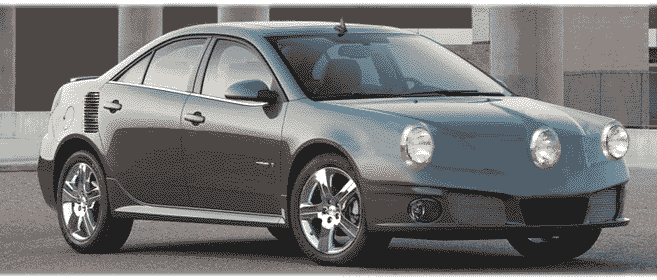
Dan subtly questioned the manliness of the Slingshot, noting that the "driver and passenger seats occupy an extreme aft position in the tube-steel space frame, relative to the outrageously wide, long hood. That, and the fact that the passenger compartment has no top, no doors and cut down thresholds, gives the Slingshot SL a distinct Ace-and-Gary vibe." That, of course refers to The Ambiguously Gay Duo from 'Saturday Night Live', part of the TV Funhouse cartoon series.
If you decide to buy one, you should practice in the mirror saying, "Good job, friend of friends." And, "Hey, what's everybody looking at?" (posted 12/15/14, permalink)
Milestone: A year after the 27 millionth Ford made the trek from San Francisco to the NY World's Fair and back, the 28 millionth Ford sedan appeared at the Fair as part of its 'International Good Will Tour'.
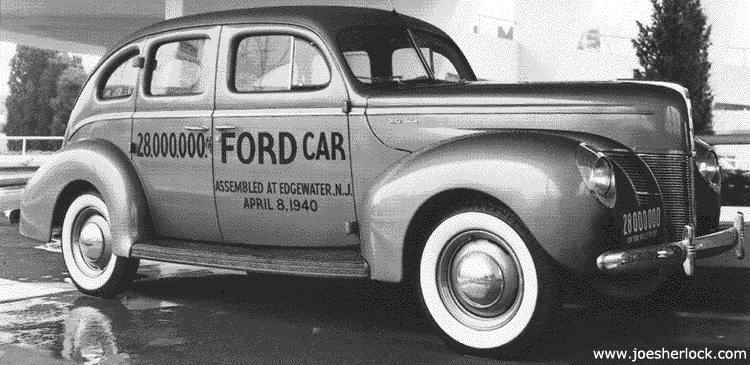
International? It probably went to Canada but I doubt that it made it to Nazi Germany. Or Poland. (posted 12/15/14, permalink)
Christmas Treat: The 1947 Sears Christmas catalog offered this Steelcraft pedal car, loosely based on the 1941 Chrysler:
Sears sold the same model for $15.72 in 1946 although the '46 model had a working horn. I can personally confirm that it was a great little pedal car - mine was a maroon color:
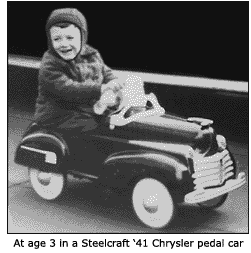
"Ask the man who owned one." (posted 12/12/14, permalink)
We Build Excitement! That used to be the slogan for Pontiac. Over the years, General Motors built millions of them.
But General Motors and Pontiac lost their way. In late November 2009, the last Pontiac rolled off the assembly line. Read more about Pontiac's rise and fall here. (posted 12/10/14, permalink)
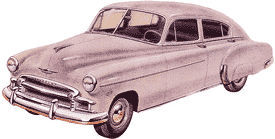 Coupe This: Four-door coupes are still big sellers, even though the rear seat area only has headroom for small children, dachshunds and midget corpses with broken necks. Coupe This: Four-door coupes are still big sellers, even though the rear seat area only has headroom for small children, dachshunds and midget corpses with broken necks.
I would remind people who think these vehicles are trendy, that the this style has been around for over 70 years.
In the 1940s they were called Torpedo sedans. In 1950, Chevrolet was still offering the Chevy Fleetline fastback.
Or consider the sleek-backed 1936 Lincoln Zephyr. Or the Pierce Silver Arrow which made its debut at the Chicago 1933 Century of Progress. Everything old is new again. (posted 12/2/14, permalink)
Remember When Olds Was Hot? In 1962, GM was selling them as fast as they could make 'em.
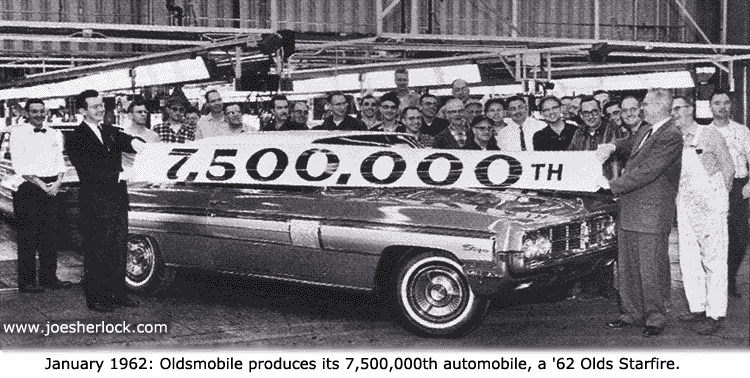
You'll find a comparison of the '56 Ford and '56 Meteor posted here. More about the 1960 Ford can be found here. (posted 11/21/14, permalink)
Is The Sports Car Market Dying? "The sports car market is roughly half of what it used to be," Ian Robertson, BMW's head of sales, said in an interview recently. "Post-2008, it just collapsed. I'm not so sure it'll ever fully recover."

According to Robertson, two factors seriously wounded the classic sports car market. First, the global economic crisis of a few years ago put a serious hurt on sales. Further worsening the situation, the boom in popularity of luxury SUVs and crossovers in the past few years hasn't allowed for much recovery. Combined, Audi TT, BMW Z4 and Mercedes-Benz SLK sales peaked around 114,000 units a year in 2007, but they are only expected to reach 72,000 annually by the end of the decade. Last month, Audi only sold 32 TTs in the U.S.
Dereck Kreindler wrote, "The other factor is that driving conditions have changed. Increased congestion, urbanization and a demonization of speeding (backed by harsh, if not draconian penalties) has made the notion of a sports car an outmoded one for many people. Even the latest 991 Porsche 911 GT3 has abandoned the manual transmission."
It should be noted that the Mazda MX5 (nee Miata) holds the record for the best-selling two-seat sports car in automotive history, according to the Guinness Book of World Records. Over a million have been sold worldwide since 1989. Less than 5,000 examples of the model are sold annually in the U.S. these days.
About 35,000 Corvettes will find buyers in 2014 - more than double last year's number because the 2014 is an all-new model. Porsche sells about 18,000 sports cars in the U.S. per year; the 911 outsells the Boxter/Cayman by about 40%. Next best-seller is the Nissan 370Z (7,700); the Mercedes SLK (4,800) comes in just below the Miata, while the Jaguar F-Type accounts for about 4,000 annual sales. 75,000-80,000 sports cars are sold in the U.S. annually, representing a very small slice - less than 0.5% - of the overall light vehicle market.
The 'sports car market' is loosely defined - not every sports coupe is a sports car and folks will argue where the line is to be drawn. Furthermore, it is also a niche market and such specialty markets are always more subject to the vagaries of fashion, style and the economy compared to more practical mainstream offerings.
Even in the days of yore, sales of sports cars in America (in the 1950s and '60s) represented a small portion of the overall vehicle market - less than 50,000 units in 1960 (led by Triumph, Austin-Healey and Corvette) to over 70,000 vehicles by 1965 (led by MG, Triumph and Corvette). These are miniscule compared with the total U.S. automobile market (7.9 million vehicles in 1960; 11.1 million in 1965). In terms of vehicular market share, things haven't really changed much.

I would posit another reason for this alleged decline of sports cars: ordinary plain-vanilla sedans have gotten so much better that today's typical sports car no longer outshines other cars so much. Car and Driver has put together a series of performance charts showing that the supercars of 50+ years ago have been eclipsed by today's everyday vehicles.
Jack Baruth provided some interesting race track numbers: "Last year, I tried the Volvo S60 T5 around Summit Point Shenandoah and was able to coax a very high 1:53 out of it. At the time, I thought the Volvo at $35K might make a case for itself against a $28K Camry, and I said as much. (it's a 1:51 lap done by a fellow driving an R-package Miata on Hankook R-compounds. Volvo was just eight seconds a lap behind a time set by a new Porsche 991S)
The Camry I brought to Shenandoah this time, however, wasn't $28K. It was $23,600, which is how much you pay for a zero-option SE four-cylinder. I'm pretty sure there's a little wiggle room in that price, too. Although my TrackMaster wasn't behaving, I almost immediately ran a 1:58 in the car.
With two additional passengers. On a track that had seen rain just hours earlier.
The next day, I easily knocked out a bunch of 1:54s. So for two-thirds the price of the Volvo, you can run the same laps. What's interesting is that the Camry does it with an seventy-two horsepower disadvantage."
So, a base, four-cylinder Toyota Camry managed a track time only a few seconds slower than an R-package Miata running on track tires. Amazing!
These days, vehicle buyers seem more interested in connectivity than acceleration and handling. Sheryl Connelly, Ford Motor's global trends manager, has stated, "Consumers today want to stay connected and they want the drive to be an experience, especially since the amount of time Americans spend in the car has nearly doubled in the last 10 years."
The market for sports cars is still very much alive. But they're no longer making as many prospective buyers' hearts go pitter-patter the way they used to. (posted 11/19/14, permalink)
Why Are These Men Unhappy?
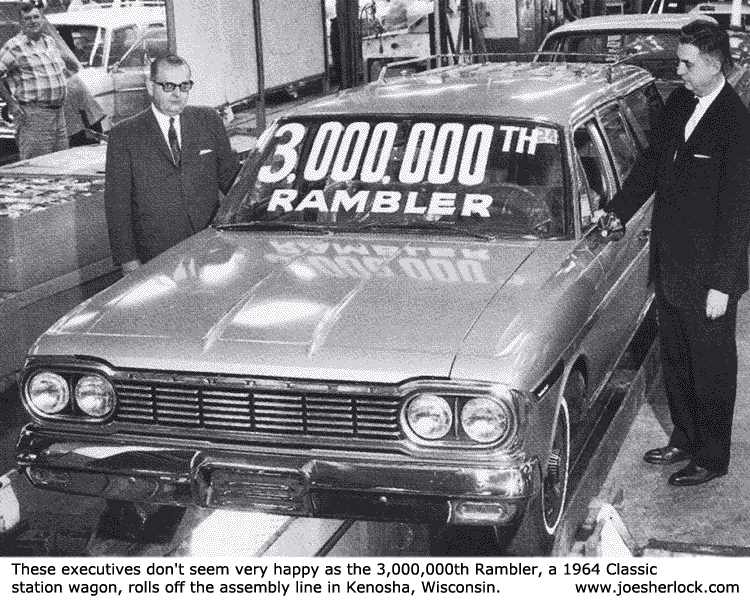
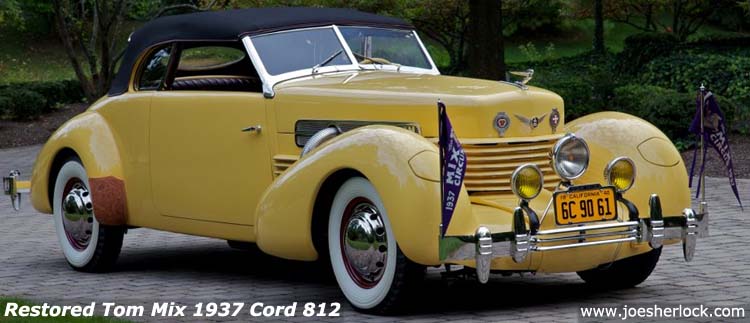
This is the same supercharged car in which he died near Florence, Arizona (southeast of Phoenix) in 1940. A flagman had stopped him and warned about roadwork in progress to repair a washed-out bridge. Ignoring the flagman, Mix drove on and plunged into a ravine; the convertible flipped, resulting in instant death. The gully has since been renamed Tom Mix Wash.
As delivered, Mix's car was one of three Cord 812 phaeton models to include a factory-installed rear tire mount, with the other two going to Al Jolson and Barbara Stanwyck. More photos of the Mix Cord can be seen here.
The body design of the Cord 810/812 was the work of designer Gordon M. Buehrig and his team of stylists. The unforgettable, handsome and distinctive coffin nose can be seen from the opposite end of any Concours show field - it's that distinctive.
The first American front-wheel drive car with independent front suspension caused a sensation at the New York Auto Show in November 1935. The crowds around the new Cord were so dense that attendees stood on the bumpers of nearby cars just to get a look. Many orders were taken at the show but no production vehicles were available until February 1936.
The 810/812 series was the last gasp of the dying Auburn-Cord-Duesenberg empire. After ACD folded, the Cord tooling was used to produce other makes of automobiles.
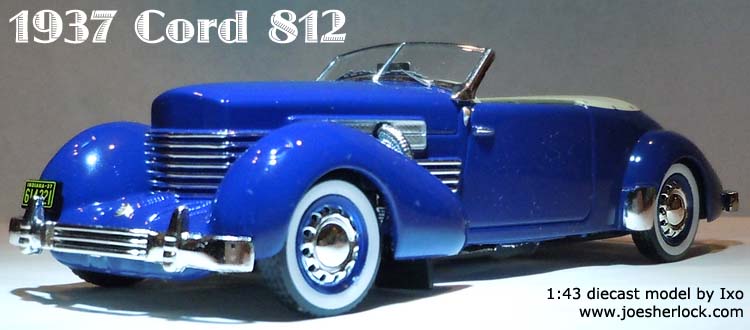
This classic automobile has been reproduced by many toy and model makers. I've posted photos of four scale-model Cord 812s here. (posted 11/5/14, permalink)
 Historic Site: The General Motors Technical Center has been chosen by the US Department of the Interior and National Park Service to be a National Historic Landmark. The Warren, Michigan complex was completed in 1955 and ceremonially on May 16, 1956 by President Dwight Eisenhower. Those were the days when General Motors had over 50% of the U.S. car market and was the world's largest auto manufacturer by a wide margin. Historic Site: The General Motors Technical Center has been chosen by the US Department of the Interior and National Park Service to be a National Historic Landmark. The Warren, Michigan complex was completed in 1955 and ceremonially on May 16, 1956 by President Dwight Eisenhower. Those were the days when General Motors had over 50% of the U.S. car market and was the world's largest auto manufacturer by a wide margin.
According to the National Park Service, the campus is receiving the honor because it "is one of the most significant works of architect Eero Saarinen, who was among the most important modernist designers of the post-World War II period in the United States."
The facility cost GM approximately $100 million at the time. The American Institute of Architects honored it in 1986 as the most outstanding architectural project of its era. The Tech Center includes 330 acres with 11 miles of roads and 1.1 miles of tunnels. It includes 25 main buildings and numerous additional structures including a water tower and 22-acre lake.
During my business career, I visited the Tech Center on multiple occasions and got to see preproduction models of cars two years before they hit the market. There were always exotic cars from foreign makers scattered around - GM would bring them in "for evaluation."
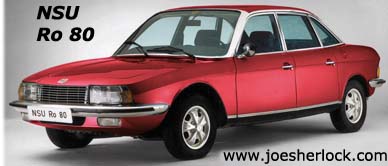
In the early '70s, I saw my first and only NSU Ro 80, the Wankel-engined, technologically-advanced German sedan parked in front of the Tech Center. It looked quite cleanly-styled and slightly futuristic in a world of period Ford Pintos, Buick Centurions and Dodge Monacos. Its 1967 sleek wedge-profile was emulated by many auto firms in subsequent decades. Despite several trips to Europe, I never saw another Ro 80. In ten years of production, less than 38,000 were made. (posted 10/22/14, permalink)
When Cars Die: Bill McBride at Calculated Rusk has looked at vehicle turnover - the time between initial sale and the wrecking yard.
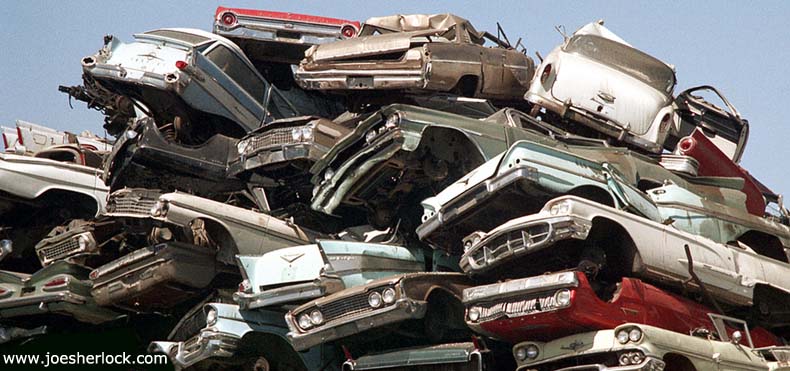
This can be calculated by dividing total registered vehicles by the annual sales rate:
Over the last 37 years, vehicle life has averaged just under 15 years and has increased slightly over over the last 10-15 year period as vehicles have gotten better and replacement cars have gotten more expensive. McBride noted, "The wild swings in 2009 were due to the "cash for clunkers" program. ... The estimated ratio for August was just over 14 years - back to a more normal level."
"The current sales rate is now near the top (excluding one-month spikes) of the '98/'06 auto boom."
Light vehicle sales were at a 17.45 million seasonally adjusted annual rate (SAAR) in August. The historical norm is in the 12-15 million/year range.
McBride said, "I now expect vehicle sales to mostly move sideways over the next few years." (posted 9/24/14, permalink)
The View From The Art Museum: This photo, taken in 1954 or thereabouts and posted on Hemmings.com, shows the view facing southeast from the Philadelphia Museum of Art, where Rocky Balboa famously ran up the steps.
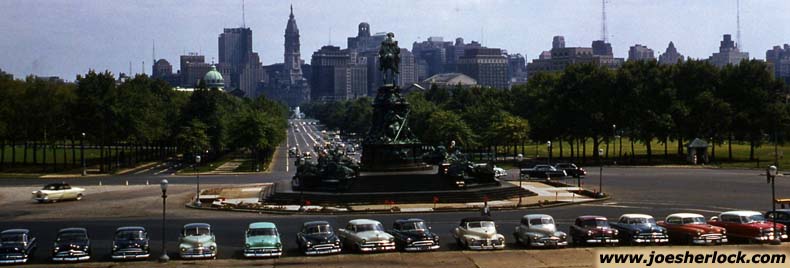
In the photo, there are a number of cars parked in front. From left to right, they are a '52 Ford, a '49 Ford and a '53 Dodge - all a dark blue color, a two-tone green 1946 Chevrolet, a turquoise '54 Ford, a dark green 1950 Chevy, a gray '53 Ford four-door sedan, a dark blue '50 Chevrolet, a cream-colored 1946 Cadillac convertible with black top, a slate-blue 1946 Buick, a maroon '51 Henry J, a white-over-blue 1954 Ford Crestline Victoria hardtop, a white-over-deep orange 1954 Pontiac Catalina hardtop coupe and a white-over-salmon 1954 Nash Country Club hardtop coupe.
Behind the parked cars is ... (more >>>)
Saint Testa Of Rossa, Pray For Us: Ferrari enthusiasts are very disturbed by the recent firing of Luca di Montezemolo, who had headed up Ferrari for over two decades and presided over record profits. He and Fiat head Sergio Marchionne disagreed about the management of the Ferrari brand. Di Montezemolo was given a $35 million Shutta-You-Mouth severance package, so the 67-year-old marquis need never work again especially since his net worth is estimated at $400 million. Fiat (FCA) owns 90% of Ferrari.
"In addition to their on-track success, Ferrari also found great financial success in the now ubiquitous merchandise licensing deals that were spearheaded by di Montezemolo, which has allowed Ferrari to maintain a lucrative revenue stream despite capping production of the cars at 7,000 units annually." Marchionne wants to expand production by 40% and broaden the model range. Many auto pundits fear that such a move would dilute the brand's exclusivity.

"The departure of di Montezemolo, who is credited with introducing (many) milestone vehicles ... is being seen as a turning point in the brand's history. Marchionne has never had experience running any premium brands and Ferrari is one of FCA's few profit centers."
Regarding Sergio Marchionne, Peter De Lorenzo wrote, "Aren't you the genius executive who has set-up Fiat Chrysler to fail after your departure, creating inevitable, long-term havoc with your 30-something direct reports and your heavy-handed micromanaging, so that you can say, "See, they can't function without me" after you retire to a life of smugness and I told you so's?"
Peter continued, "Montezemolo's disdain for Marchionne has now come to the surface. "Ferrari is now American," which represents "the end of an era," Montezemolo told close associates, Il Corriere della Sera reported today. So the mercenary deal maker, who has no respect for the integrity of the product or the brand exclusivity of Ferrari, wants to expand production to make more money so he'll look like even more of a genius, at least in his own mind. In other words, Marchionne is fulfilling his mission as the consummate stronzo. I've seen this movie before at other car companies, and it never ends well. ... and we all know what happened to Lancia. ... Not good news for Ferrari, Mr. Marchionne is a bean counter. I don't think he has any interest in cars other than money."
Indeed, look what Marchionne has done to Lancia, a once-proud brand. The iconic Lancia automobile seems to be headed down the same hole as Mercury and Pontiac. New, unique models are long gone and the brand is almost nonexistent outside Italy. The plan is for most Lancias to be nothing more than rebadged Chryslers.
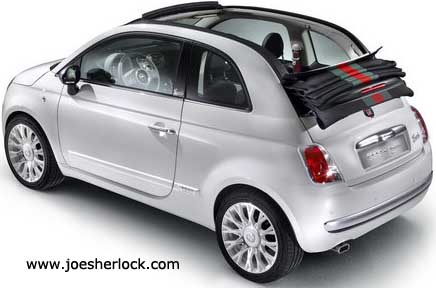 Then there's Fiat's American faceplant. Fiat had positioned its 500 minicar is as stylish as Italian supermodel Bianca Balti. U.S. sales of the tiny auto now show that Americans perceive the little Fiat as more like Ugly Betty. Sergio Marchionne stated that the 500 would "transform the U.S. market" and that the automaker would easily sell 50,000 units in the first year. Today, despite an expanded product line and Lee Iacocca-like 'special editions', Fiat sales are less than 3,400 per month in a record-setting U.S. auto sales environment. Then there's Fiat's American faceplant. Fiat had positioned its 500 minicar is as stylish as Italian supermodel Bianca Balti. U.S. sales of the tiny auto now show that Americans perceive the little Fiat as more like Ugly Betty. Sergio Marchionne stated that the 500 would "transform the U.S. market" and that the automaker would easily sell 50,000 units in the first year. Today, despite an expanded product line and Lee Iacocca-like 'special editions', Fiat sales are less than 3,400 per month in a record-setting U.S. auto sales environment.
Then there's other failure stories like the near-extinct Viper and the oft-promised, still-undelivered Alfa Romeo lineup in North America.
Fiat's business in Europe has fallen apart as the EU economy has worsened. Fiats have a reputation in the old country for marginal quality. (That's true in the U.S. as well. In a recent J.D. Power 2014 Initial Quality Study, Fiat finished last with 206 problems per 100 vehicles sold. The industry average was 116.)
In Europe, Fiat has been losing market share to Japanese - and lately, Korean - offerings. Chrysler Group's U.S. sales - mostly Jeep and Ram trucks - have been the only reason the Italian carmaker continued to post profits.
In Consumer Reports' Annual Auto Issue, the lowest rated brand was Dodge with a score of 46: "Most Dodges are unreliable and even the new Dart is not competitive with the best in its class." Second worst score went to Jeep. In the compact field, the Ford Focus outsells the Dodge Dart by three-fold; the Honda Civic outsells the Dart by an even larger margin. The Dart is based on the Alfa Romeo Giulietta platform and is produced in Illinois at the Belvidere Assembly Plant.
Dodge sales are down; the brand is now moving less than 50,000 vehicles per month. (As of this writing, Dodge is offering Dart SXTs on a two-year lease for $99/month - sounds like a desperation move.) Chrysler has moved downscale enough that it has encroached on Dodge's territory. Chrysler is apparently becoming the new Dodge. Or Plymouth. Strange world. Despite all the pumping up, Chrysler sales are under 30,000 per month.
FCA (the Netherlands-based company that now owns Chrysler and Fiat) is being saved by strong sales of its fast-growing (up year-over-year 39%) Ram truck brand, with sales over 45,000 per month and growing. Then there's Jeep, which sold over 68,000 units last month - up 49% from the previous August.
Unfortunately, the new Jeep Cherokee - based on an Alfa Romeo platform - was not well received by Consumer Reports. CR noted that "the new nine-speed automatic transmission is unrefined, the ride is choppy, handling lacks agility and visibility is so-so. The 184 hp ... engine feels anemic and averaged just 22 mpg overall."
Chrysler-Fiat is a tiny player in China's huge vehicle market, selling 130,000 vehicles there in 2013. The company plans to start manufacturing Jeeps there in 2015 in a joint venture with Guangzhou Automobile Group. In 2017, the company will begin exports of the Wrangler and Grand Cherokee to China. The Grand Wagoneer, an SUV with three rows of seats, will join them in 2018. Good luck with that.
Marchionne is a great self-promoter but his track record with brand management isn't so hot. And FCA seems to be built on a foundation of crumbling biscotti.
Pray for the soul of Ferrari. (posted 9/18/14, permalink)
New Problems Vs. Old Problems: In a recent TTAC article about the various electronic glitches plaguing owners of Teslas, there were interesting readers' comments pointing out that the good old days weren't exactly a cake walk.

"If you think modern electronics are awful, check the vacuum-actuated controls in some older iron. ... You've had to live through the days of vacuum controlled emissions controls (and windshield wipers!) to appreciate how far we've come … My Thunderbird has hydraulically-powered wipers. Reliable as long as you keep your power steering in good order." My good friend Rich McFall once owned a purple 1953 Oldsmobile convertible that had hydraulic power windows. The problem was, they leaked and if you touched a window button, a stream of hydraulic fluid would spray the front of your trousers.
"My ’97 Jetta VR6 has vacuum-operated central door locks. It is equipped with an original keyless-entry system, so it's always odd to press the unlock button and then hear that whirring delay for a couple of seconds before the locks disengage. If there's ever a leak in the system - and there might already be - it's going to be a complete pain to get in and fix it." My 1979 Lincoln Town Car also had vacuum door locks. They worked reluctantly, verrrrry slowly or sometimes not at all.
"Those diagrams on the hoods and slam panels of older cars always scared the hell out of me. No way would I want to chase down a problem in that kind of system." Yes, well the fold-out electrical diagrams in those oversized service manuals were equally frightening to me.
One poster lamented "The good old days of behavior-engineered traction control. No one is going to floor it in the rain if it shuts off the wipers." Ha! This is why I don't drive my '39 Plymouth coupe in the rain. It still has vacuum wipers. And no traction control.
 "A coworker had an old Beetle that uses the air from the spare tire to pressurize the washer fluid reservoir." Yes, and the seam on the VW's pressurized polyethylene windshield washer tank would burst every couple of years or so, providing a nice income stream for Volkswagen's parts department. "A coworker had an old Beetle that uses the air from the spare tire to pressurize the washer fluid reservoir." Yes, and the seam on the VW's pressurized polyethylene windshield washer tank would burst every couple of years or so, providing a nice income stream for Volkswagen's parts department.
It happened regularly on every one of the three Beetles I owned.
Despite all of the disconcerting modern technology of today, the Good Old Days weren't so great either.
Let's not forget that ordinary, low-cost cars of today offer so much compared with cars of 50 years ago: Fast performance, high gas mileage, unheard-of safety features and so many luxury touches - power windows, door locks and side mirrors, cruise control, auto-dimming mirrors, power disc brakes, lumbar adjustment, killer audio system, heated rear window defroster, keyless entry system, alloy wheels, etc.
I think that the variety of audio options available in today's cars would astound people. (Most '64 cars didn't even have FM radios.) So would the quality of sound. And the features available because of the use onboard computers. And navigational systems.
Ordinary 2014 sedans will run circles around most 1964 sports cars. On the straightaway and in the curves. And get decidedly better gas mileage.
Overall quality and serviceability of today's vehicles would wow people of 50 years ago. The worst cars of 2014 are better than the finest cars of 1964 in terms of fit, finish and reliability. You rarely see relatively-new cars broken down on the side of the road - a not-uncommon sight fifty years ago. People would be astonished by the very concept of 100,000 miles between tune-ups. (A 1964 VW Beetle required an oil change every 1,500 miles and valve adjustment every 3,000 miles.)
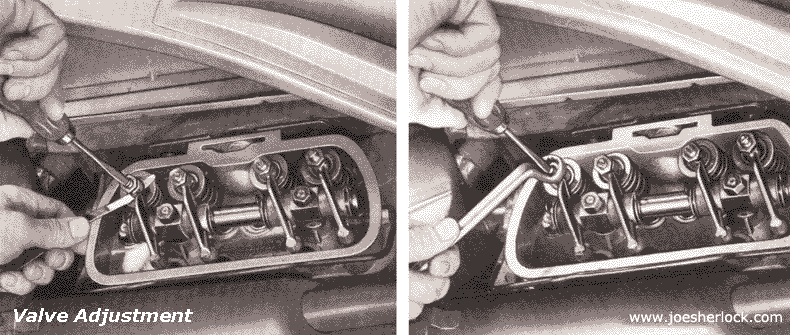
Then there's safety - can you even imagine doing a 40 mph offset barrier crash in a '64 Mercury Comet? The widespread availability of ABS braking systems, traction control, directional stability control, multiple air bags, etc. would be incomprehensible to most people back in 1964. (posted 8/27/14, permalink)
Beaters: Jack Baruth recently wrote a piece for TTAC about the use of rental cars for road tests. This is necessary because many manufacturers won't give TTAC cars to test since the writers call 'em as they see 'em and that does not please the boyz in Detroit. Or Spartanburg. Or Stuttgart.
There was much discussion about whether rental cars are abused. There was no clear consensus and I have no definite answer either. When I rent cars these days, I drive them like the geezer I am. When I was younger, it was sometimes a different story:
I hope that pathetic red '85 Nissan Sentra rental appliance eventually found a kind, loving home in Honolulu. Or a dignified burial at sea. (posted 8/25/14, permalink)
Separated At Birth:
RIP: William Clay Ford, Edsel Ford's youngest child and the last surviving grandchild of Henry Ford, has died at age 88.
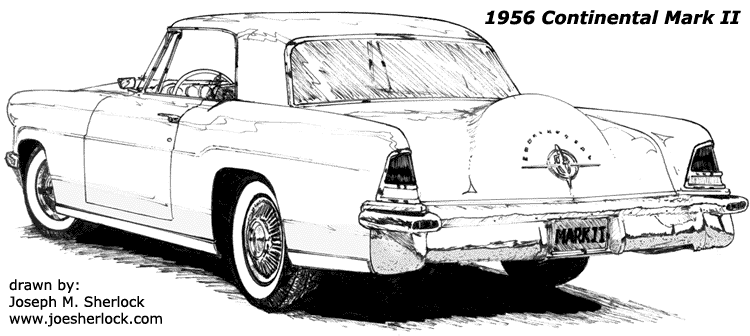
Ford served as the owner and chairman of the Detroit Lions and was briefly head of the FoMoCo's Continental Division. He championed the iconic Continental Mark II automobile. It is said there were only two pictures on his office wall, his father's Continental and his Mark II. (posted 3/10/14, permalink)
The Italian Mercury: Or maybe Oldsmobile. Speaking with Italian newspaper La Repubblica, Fiat CEO Sergio Marchionne indicated that the Lancia brand will be stripped down to one model, and even that will only be sold in Italy itself.
Another legendary brand bites the dust. Sad. Founded in 1906, Lancia has a long tradition of producing fast touring, sports and racing cars. Memorable ones, too - like the Lancia Aurelia luxury touring car of the 1950s and its successor, the Flaminia. Or the Stratos.
I've written about Lancia's troubles before. With little cash left after the Chrysler buyout, Fiat has chosen to spend its remaining money trying to revive the Alfa Romeo marque. (posted 1/27/14, permalink)
2014 Detroit Auto Show: Throughout my life, I have faithfully followed auto show coverage because I wanted to see what the future held by looking at all the wild concept cars on display. Alas, I continue to be disappointed by the lack of far-out machinery, such as bubble-topped flying cars, at this year's Detroit Auto Show.
When I was growing up, magazines like Popular Mechanics, Mechanix Illustrated and Popular Science predicted that tires and roads would soon be obsolete and we'll get around in flying cars with Plexiglas roofs.

Such stories were profusely illustrated; the renderings often appeared in full color on the cover to help boost newsstand sales. The skies were always clear blue with nary a belching smokestack in sight. (Perhaps the illustrators were prescient enough to realize that, in the future, factories would disappear because everything would be manufactured in China.) Sometimes the flying cars were piloted by silver robots with red eyes. Occasionally flying semis and buses would be visible in the background.
 As a youngster, I was promised Social Security in my old age. As a 12 year-old, I could have cared less. As I grew older, I was told over and over that Social Security was "in trouble," "bankrupt" and/or "on the brink of collapse." I made other financial plans just in case and was pleasantly surprised when I actually started getting SS payments. That's the kind of surprise I like: give me something I wasn't really expecting. As a youngster, I was promised Social Security in my old age. As a 12 year-old, I could have cared less. As I grew older, I was told over and over that Social Security was "in trouble," "bankrupt" and/or "on the brink of collapse." I made other financial plans just in case and was pleasantly surprised when I actually started getting SS payments. That's the kind of surprise I like: give me something I wasn't really expecting.
On the other hand, if you promise me something and I don't receive it, I get angry. So I'm peeved that I can't buy a Plexi-domed flying car. No one ever told me that aerocars were "in trouble" or that the entire concept was "on the brink of collapse."
Never mind that Plexiglas acrylic was far more expensive than glass, that it scratched very easily and that the forming process for making those domed roofs would thin out the material at the top - the very spot where strength and rigidity were most needed.
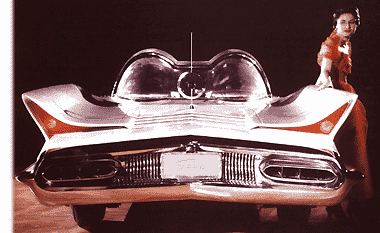 Sitting in a parked car in the Southern California sun, a Plexiglas canopy would have you fry and die of heat stroke in about four minutes. None of this stopped the press from predicting that all cars would soon have transparent plastic bubble roofs for all-around driver visibility. Sitting in a parked car in the Southern California sun, a Plexiglas canopy would have you fry and die of heat stroke in about four minutes. None of this stopped the press from predicting that all cars would soon have transparent plastic bubble roofs for all-around driver visibility.
Speaking of acrylic domes, we were also told that we'd soon live in domed cities with climate control and our second car would be a small commuter helicopter. With a bubble windshield/canopy, of course. Our homes would have central courtyards covered with a transparent plastic hemisphere to keep the weather out, help the plants grow and allow our robot servants to recharge their solar batteries. Clear plastic bubbles would permeate our lives. We'd be part of a bubble nation living an a bubble-based economy.
The Doming of America reached its peak with the introduction of the clear plastic Cone of Silence on 'Get Smart' in 1965. The bubble economy collapsed shortly thereafter. And, apparently, so did the idea of flying cars. (It certainly didn't help the cause of clear structures when the 200-foot-tall Montreal Biosphere, a geodesic dome which was part of Expo 67, caught fire creating a gigantic Plexiglas-fueled torch.)
While there were no bubble-topped flying cars to be seen at this year's Detroit show - the one precociously renamed the North American International Auto Show, there were some new model introductions of curious interest:
• Ford debuted the 2015 Ford F-150 pick-em-up truck with its massive vintage Remington Electric Shaver front end. The butched-up F150 features an aluminum body to save 700 pounds of weight. This sounds fine on paper but have you ever owned a vehicle with aluminum body panels? Doors are easily dented by parking lot dings and stones which chip paint on most cars will often dent the hoods of aluminum-bodied ones.
Considering the heavy use and many bumps and bangs that working pickups experience, this aluminum body thing seems like a bad idea. Nevertheless, FoMoCo CEO Alan Mulally said the use of the lighter metal would "proliferate across our lineup." Ding!
• At Volkswagen, the fake Beetle has spawned a faux Dune Buggy concept - and not a very good one, with the unimaginative moniker of the Beetle Dune. Where's Bruce Meyer and his Manx when you need him? Dune the Beetle will have as much success as Dune the Movie.
• Speaking of nostalgia trips, the SRT Viper is now available in that old Dodge Challenger hideous, bilious green. Welcome to 1971. You might look good in it if you're wearing a doubleknit leisure suit in a 1970s colorful moiré pattern - especially if you're humming a Bee Gees song. Just look at that color and start singing, 'How Can You Mend a Broken Heart?'
• Then there's good nostalgia: Ford announced that it has teamed up with United Pacific Industries to offer officially licensed body shells for its 1932 Ford 5-Window Coupe. Well, they are popular. I saw a lot of '32 Fords at a recent Dr. George Car Show:
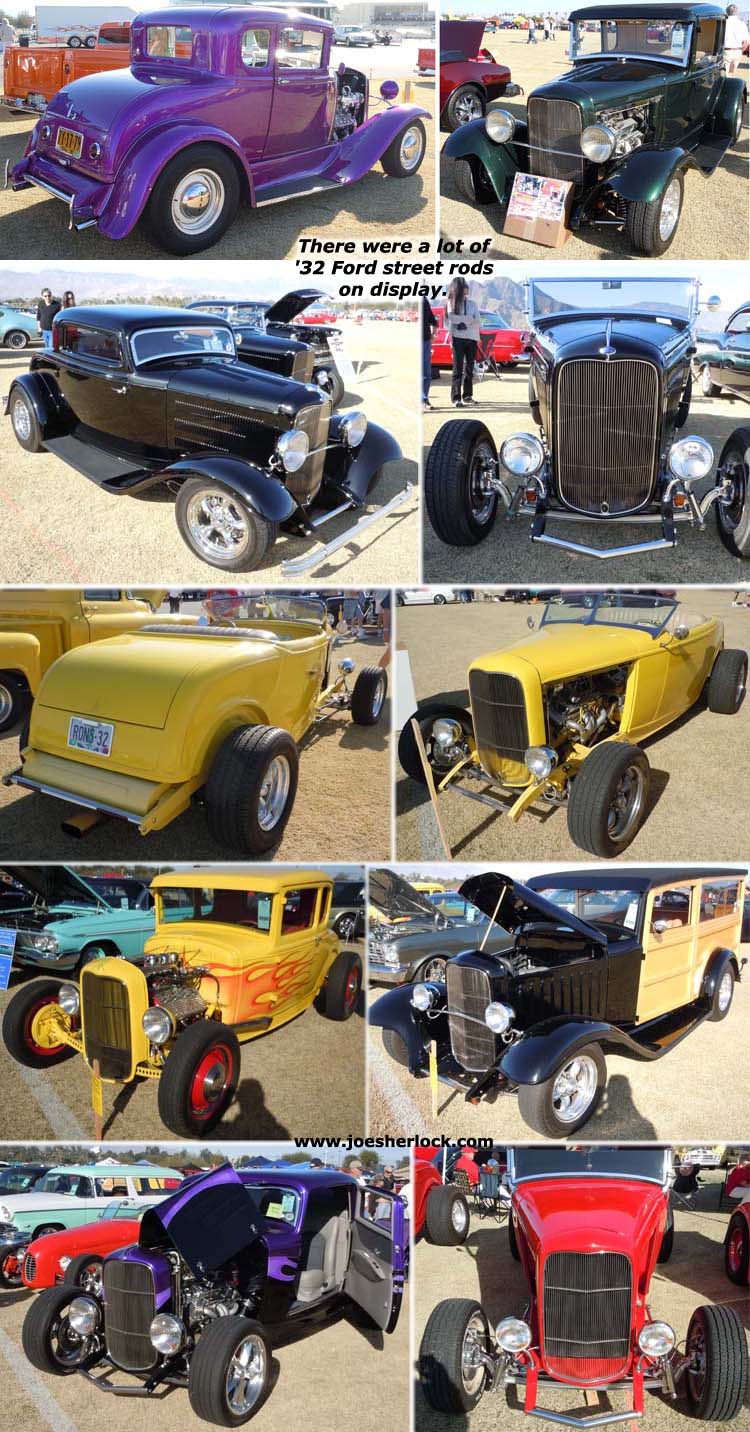
"With the 1932 Ford 5-Window Coupe body shell, you can literally build a classic-looking hot rod, ordering Ford restoration parts right from your computer, and avoid visiting a wrecking yard," said Dennis Mondrach, restoration licensing manager, Ford Component Sales. "The coupe body shell joins our growing list of ready-to-build stamped steel body shells, including the classic 1965-70 Mustangs and 1940 Ford Coupe."
• The all-new-for-2015 Honda Fit is almost two inches shorter than the already-tiny model it replaces. And Honda is trying to sell it in the U.S. - a land where most people don't want minicars. The Civic and Accord outsell the Fit by six- and seven-fold, respectively.
So Honda decided to try and improve the Fit's U.S. sales by making it a little smaller. Go figure.
• Jack Baruth wrote, "No other car on the planet combines technological supremacy and ventricle-bursting depreciation like a modern V12-powered Mercedes-Benz." True dat. And the new Mercedes S600 costs a bundle; but it has V12 emblems on it, something you can't easily find on a hang tag at AutoZone.
The big Merc has a quilted leather interior, something I've only seen before on old Chevies at low-rider shows. Nevertheless, dictators and tyrants will love the S600. I liked it better when it carried those Pullman badges in the 1960s. Tito, Pol Pot, Elvis, Karen Carpenter and Coco Chanel used to ride in 600s.
• Mercedes also showed the Concept S-Class Coupe which made its debut at the Frankfort Auto Show last Fall. It looks long, swoopy and Benz-Expensive. I like it.
• I'm not a fan of current Cadillac styling but the new little 2015 ATS coupe is quite the looker.
• The Kia GT4 Stinger concept coupe looks butt ugly - except from the back. The front end is particularly off-putting. But then, old geezers like me are not the target market, so my opinion doesn't count.
• While on the subject of coupes, the 2015 Lexus RC F has the ugliest nose in the business. What is it with Asian cars and hideous front beaks? Consider the alien insect proboscis of the Nissan Sport Sedan Concept.
Sigh. Maybe next year, I'll be able to buy a transparent-canopied flying car. Hope springs eternal. (posted 1/17/14, permalink)
Earlier Car Musings can be found here.
Other Pages Of Interest
| blog: 'The View Through The Windshield' |
| greatest hits: various essays & articles | blog archives | '39 Plymouth | model train layout |
| about me | about the blog | e-mail |
copyright 2014-21 - Joseph M. Sherlock - All applicable rights reserved
Disclaimer
The facts presented on this website are based on my best guesses and my substantially faulty geezer memory. The opinions expressed herein are strictly those of the author and are protected by the U.S. Constitution. Probably.
Spelling, punctuation and syntax errors are cheerfully repaired when I find them; grudgingly fixed when you do.
If I have slandered any brands of automobiles, either expressly or inadvertently, they're most likely crap cars and deserve it. Automobile manufacturers should be aware that they always have the option of trying to change my mind by providing me with vehicles to test drive.
If I have slandered any people or corporations, either expressly or inadvertently, they should buy me strong drinks (and an expensive meal) and try to prove to me that they're not the jerks I've portrayed them to be. If you're buying, I'm willing to listen.
Don't be shy - try a bribe. It might help.
|

